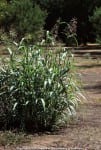Insight from Johnsongrass Mapping
Kearney Agricultural Research and Extension Center Director Jeff Dahlberg says johnsongrass is really resilient. His part of a collaborative project with researchers across the U.S. will look at mapping the weed in California and that might help them find information that will lead to new management practices.
More about the project
From UC ANR: A team of researchers has received a $5 million grant from the U.S. Department of Agriculture to find new ways to combat Johnsongrass, one of the most widespread and troublesome agricultural weeds in the world.
“Johnsongrass is a huge problem,” said Jeff Dahlberg, UC Cooperative Extension sorghum specialist and director of the UC Kearney Agricultural Research and Extension Center in Parlier, Calif. “It impacts many different crops and is very hard to control.”
Dahlberg is part of the team that includes scientists from Virginia, Kansas, North Carolina, Texas and Georgia. Andrew Paterson, director of the Plant Genome Mapping Laboratory at the University of Georgia, Athens, is the lead investigator.
Native to the Mediterranean region, Johnsongrass has spread across every continent except Antarctica. It was introduced to the U.S. in the 1800s as a forage crop, but it quickly spread into surrounding farmland and natural environments, where it continues to cause millions of dollars in lost agricultural revenue each year, according to the USDA.
The naturalization of Johnsongrass across much of the U.S. has also allowed the plant to develop attributes — such as cold and drought tolerance, resistance to pathogens and the ability to flourish in low-fertility soils — that make it particularly difficult to control. Adding to the challenge is the adoption of herbicide-resistant crops around the world.
“Herbicide-resistant crops have been associated with a dramatic increase in herbicide-resistant weeds,” Patterson said. “With 21 genetically similar but different types of Johnsongrass known to be resistant to herbicides, it will only become more problematic in the future.”
Over the course of their five-year project, the researchers will work to better understand the weed’s capabilities and the genes that make Johnsongrass so resilient. Johnsongrass [Sorghum halepense] is closely related to sorghum [Sorghum bicolor (L.) Moench], a healthy gluten-free grain, animal feed and biofuel crop. Lessons learned from the Johnsongrass research may lead to strategies to improve sorghum. Read more from UC ANR.










